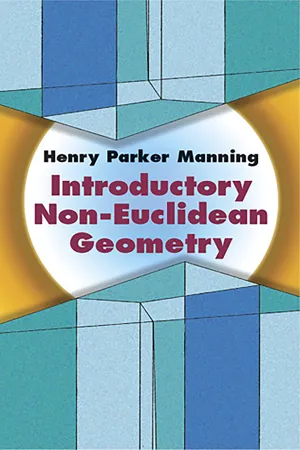
This is a test
- 112 pages
- English
- ePUB (mobile friendly)
- Available on iOS & Android
eBook - ePub
Introductory Non-Euclidean Geometry
Book details
Book preview
Table of contents
Citations
About This Book
This fine and versatile introduction to non-Euclidean geometry is appropriate for both high-school and college classes. Its first two-thirds requires just a familiarity with plane and solid geometry and trigonometry, and calculus is employed only in the final part. It begins with the theorems common to Euclidean and non-Euclidean geometry, and then it addresses the specific differences that constitute elliptic and hyperbolic geometry. Major topics include hyperbolic geometry, single elliptic geometry, and analytic non-Euclidean geometry. 1901 edition.
Frequently asked questions
At the moment all of our mobile-responsive ePub books are available to download via the app. Most of our PDFs are also available to download and we're working on making the final remaining ones downloadable now. Learn more here.
Both plans give you full access to the library and all of Perlego’s features. The only differences are the price and subscription period: With the annual plan you’ll save around 30% compared to 12 months on the monthly plan.
We are an online textbook subscription service, where you can get access to an entire online library for less than the price of a single book per month. With over 1 million books across 1000+ topics, we’ve got you covered! Learn more here.
Look out for the read-aloud symbol on your next book to see if you can listen to it. The read-aloud tool reads text aloud for you, highlighting the text as it is being read. You can pause it, speed it up and slow it down. Learn more here.
Yes, you can access Introductory Non-Euclidean Geometry by Henry Parker Manning in PDF and/or ePUB format, as well as other popular books in Mathematics & Geometry. We have over one million books available in our catalogue for you to explore.
Information
CHAPTER I
PANGEOMETRY
I. PROPOSITIONS DEPENDING ONLY ON THE PRINCIPLE OF SUPERPOSITION
1. Theorem. If one straight line meets another, the sum of the adjacent angles formed is equal to two right angles.
2. Theorem. If two straight lines intersect, the vertical angles are equal.
3. Theorem. Two triangles are equal if they have a side and two adjacent angles, or two sides and the included angle, of one equal, respectively, to the corresponding parts of the other.
4. Theorem. In an isosceles triangle the angles opposite the equal sides are equal.
Bisect the angle at the vertex and use (3).
5. Theorem. The perpendiculars erected at the middle points of the sides of a triangle meet in a point if two of them meet, and this point is the centre of a circle that can be drawn through the three vertices of the triangle.

Proof. Suppose EO and FO meet at O. The triangles AFO and BFO are equal by (3). Also, AEO and CEO are equal. Hence, CO and BO are equal, being each equal to A O The triangle BCO is, therefore, isosceles, and OD if drawn bisecting the angle BOC will be perpendicular to BC at its middle point.
6. Theorem. In a circle the radius bisecting an angle at the centre is perpendicular to the chord which subtends the angle and bisects this chord.
7. Theorem. Angles at the centre of a circle are proportional to the intercepted arcs and may be measured by them.
8. Theorem. From any point without a line a perpendicular to the line can be drawn.
Proof. Let P′ be the position which P would take if the plane were revolved about AB into coincidence with itself. The straight line PP’ is then perpendicular to AB.
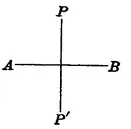
9. Theorem. If oblique lines drawn from a point in a perpendicular to a line cut off equal distances from the foot of the perpendicular, they are equal and make equal angles with the line and with the perpendicular.
10. Theorem. If two lines cut a third at the same angle, that is, so that corresponding angles are equal, a line can be drawn that is perpendicular to both.
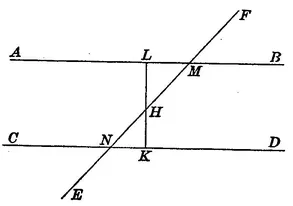
Proof. Let the angles FMB and MND be equal, and through H, the middle point of MN, draw LK perpendicular to CD; then LK will also be perpendicular to AB. For the two triangles LMH and KNH are equal by (3).
11. Theorem. If two equal lines in a plane are erected perpendicular to a given line, the line joining their extremities makes equal angles with them and is bisected at right angles by a third perpendicular erected midway between them.
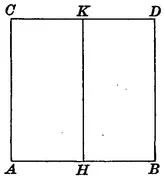
Let AC and BD be perpendicular to AB, and suppose AC and BD equal. The angles at C and D made with a line joining these two points are equal, and the perpendicular HK erected at the middle point of AB is perpendicular to CD at its middle point.
Proved by superposition.
12. Theorem. Given as in the last proposition two perpendiculars and a third perpendicular erected midway between them; any line cutting this third perpendicular at right angles, if it cuts the first two at all, will cut off equal lengths on them and make equal angles with them.
Proved by superposition.
Corollary. The last two propositions hold true if the angles at A and B are equal acute or equal obtuse angles, HK being perpendicular to AB at its middle point. If AC = BD, the angles at C and D are equal, and HK is perpendicular to CD at its middle point; or, if CD is perpendicular to HK at any point, K, and intersects AC and BD, it will cut off equal distances on these two lines and make equal angles with them.
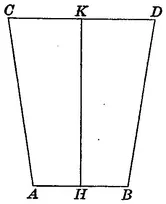
II. PROPOSITIONS WHICH ARE TRUE FOR RESTRICTED FIGURES
The following propositions are true at least for figures whose lines do not exceed a certain length. That is, if there is any exception, it is in a case where we cannot apply the theorem or some step of the proof on account of the length of some of the lines. For convenience we shall use the word restricted in this sense and say that a theorem is true for restricted figures or in any restricted portion of the plane.

1. Theorem. The exterior angle of a triangle is greater than either opposite interior angle (Euclid, I, 16).
Proof. Draw AD from A to the middle point of the opposite side and produce it to E, making DE = AD. The two triangles ADC and EBD are equal, and the angle FBD, being greater than the angl...
Table of contents
- DOVER BOOKS ON MATHEMATICS
- Title Page
- Copyright Page
- PREFACE
- Table of Contents
- NON-EUCLIDEAN GEOMETRY - INTRODUCTION
- CHAPTER I - PANGEOMETRY
- CHAPTER II - THE HYPERBOLIC GEOMETRY
- CHAPTER III - THE ELLIPTIC GEOMETRY
- CHAPTER IV - ANALYTIC NON-EUCLIDEAN GEOMETRY
- HISTORICAL NOTE